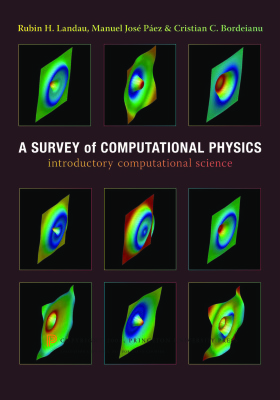Princeton University Press, Princeton and Oxford, 2008, 698 pp.
In the decade since two of us wrote the book Computational Physics, we have seen a good number of computational physics texts and courses come into existence. This is good. Multiple texts help define a still-developing field and provide a choice of viewpoints and focus. After perusing the existing texts, we decided that the most worthwhile contribution we could make was to extend our Computational Physics text so that it surveys many of the topics we hear about at computational science conferences. Doing that, while still keeping the level of presentation appropriate for upper-division undergraduates or beginning graduate students, was a challenge.
Contents.
Preface.
Computational Science Basics.
Errors and Uncertainties in Computations.
Visualization Tools.
Object-Oriented Programs: Impedance & Batons.
Monte Carlo Simulations (Nonthermal).
Integration.
Differentiation & Searching.
Solving Systems of Equations with Matrices; Data Fitting.
Differential Equation Applications.
Fourier Analysis: Signals and Filters.
Wavelet Analysis & Data Compression.
Discrete & Continuous Nonlinear Dynamics.
Fractals & Statistical Growth.
High-Performance Computing Hardware, Tuning, and Parallel Computing.
Thermodynamic Simulations & Feynman Quantum Path Integration.
Simulating Matter with Molecular Dynamics.
PDEs for Electrostatics & Heat Flow.
PDE Waves: String, Quantum Packet, and E&M.
Solitons & Computational Fluid Dynamics.
Integral Equations in Quantum Mechanics.
Appendices.
In the decade since two of us wrote the book Computational Physics, we have seen a good number of computational physics texts and courses come into existence. This is good. Multiple texts help define a still-developing field and provide a choice of viewpoints and focus. After perusing the existing texts, we decided that the most worthwhile contribution we could make was to extend our Computational Physics text so that it surveys many of the topics we hear about at computational science conferences. Doing that, while still keeping the level of presentation appropriate for upper-division undergraduates or beginning graduate students, was a challenge.
Contents.
Preface.
Computational Science Basics.
Errors and Uncertainties in Computations.
Visualization Tools.
Object-Oriented Programs: Impedance & Batons.
Monte Carlo Simulations (Nonthermal).
Integration.
Differentiation & Searching.
Solving Systems of Equations with Matrices; Data Fitting.
Differential Equation Applications.
Fourier Analysis: Signals and Filters.
Wavelet Analysis & Data Compression.
Discrete & Continuous Nonlinear Dynamics.
Fractals & Statistical Growth.
High-Performance Computing Hardware, Tuning, and Parallel Computing.
Thermodynamic Simulations & Feynman Quantum Path Integration.
Simulating Matter with Molecular Dynamics.
PDEs for Electrostatics & Heat Flow.
PDE Waves: String, Quantum Packet, and E&M.
Solitons & Computational Fluid Dynamics.
Integral Equations in Quantum Mechanics.
Appendices.

